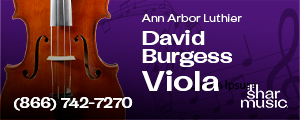The A String
March 29, 2012 at 12:38 AM
A common problem: I perform better alone than with an audience. As a rule, when I practice each day I am relatively relaxed. When I make a mistake I can go and work on that measure, or those two notes, for five minutes, or ten. I can play things over, slow it down, check my intonation, stop and start again if I am out of sync with the metronome. But during a lesson I feel much more tense. I worry about mistakes, my intonation goes south, my left hand gets tight faster and I play lots of unintentional double stops. My teacher reminds me to relax my hand, and I do. That helps. She it certainly not critical about any mistakes I make. I bought a book on the Alexander technique. I’ll see how much I can glean from it before I run off to find an Alexander teacher. I have read that the Alexander technique is used widely in music performance, the name keeps coming up. Does anyone want to share his or her experiences?So today’s lesson was frustrating like that. I had practiced Kayser op. 20, number 1: staccato staccato slur, down up doowwn, up down uuuppp. It was surprisingly hard to do it consistently. But I worked at it and it got better. But during my lesson it kind of fell apart. Squeaking, too may up bows, no slur…. So my teacher said she wanted me to just bow. I said I did that. I practiced the bowing pattern on an open A. But she wants me to do it silently, bow above the string, with string changes. Fascinating! I have no idea how to do that. I have no idea where the string changes are. I need to hear the music, to finger the notes, in order to do the bowing. This is a great exercise. It will help me learn the bowing much more solidly, learn the bowing pattern independent of the fingering. The same goes, of course, for the fingering. Learn the fingering independent of the bowing. I think I will have to mark the music to indicate where string changes are. I guess I could just recognize them by where they are on the staff. I have to figure out an approach to this exercise. Any suggestions from readers are welcome.
So also today I moved on from the first two pieces in Suzuki book 2. Handel and Bach. These were easy pieces that allowed me to work on musicality and dynamics. Dig in the bow to accent the beginning of the note. Play piano here, forte here, crescendo and decrescendo. I have lived with music all my life, listening to it. But playing gives me a whole new appreciation for the complexities of a piece (yes, I find these pieces complex).
But again I look forward to practicing in the morning. Struggling with an awkward instrument that someday I will get a consistently beautiful sound out of. I read on another violinist.com blog that it seemed reasonable for that person—another adult beginner I think—to be playing with a community orchestra in 3-5 years. OK, but I have my heart set on chamber music.
I would be interested in any recollections people might have of their starting out, especially as older students.
This entry has been archived and is no longer accepting comments.
Violinist.com is made possible by...
Dimitri Musafia, Master Maker of Violin and Viola Cases
International Violin Competition of Indianapolis
Violinist.com Holiday Gift Guide
Johnson String Instrument/Carriage House Violins
Subscribe
Laurie's Books
Discover the best of Violinist.com in these collections of editor Laurie Niles' exclusive interviews.

Violinist.com Interviews Volume 1, with introduction by Hilary Hahn

Violinist.com Interviews Volume 2, with introduction by Rachel Barton Pine






